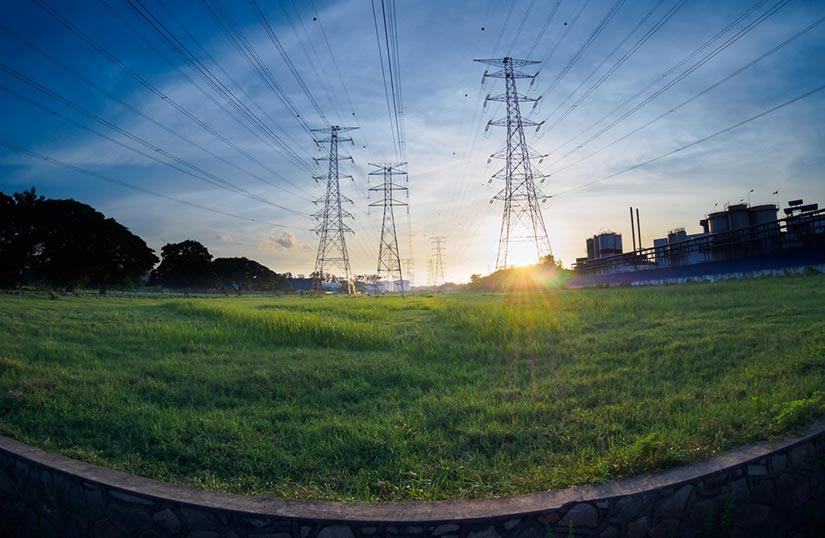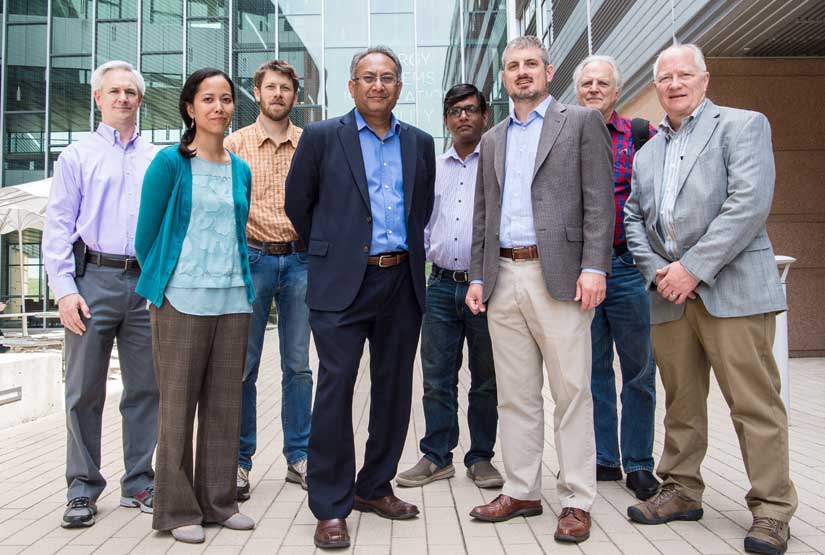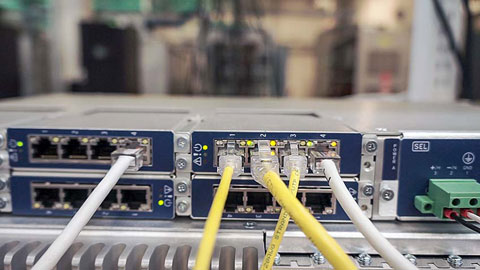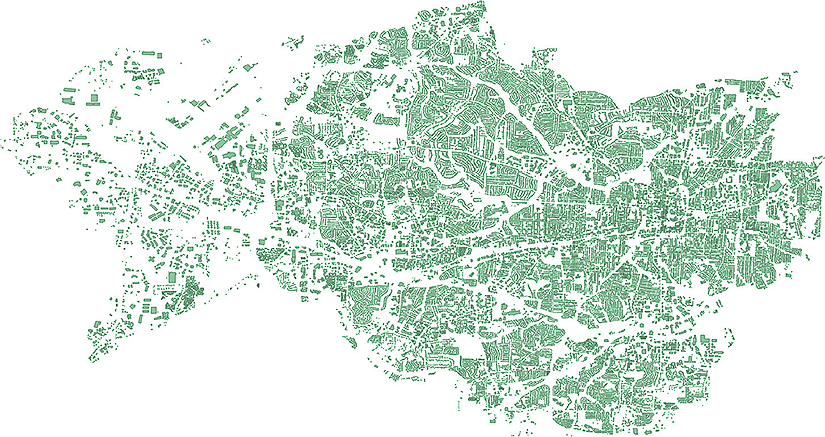Creating Consensus in Grid Modernization
How NREL Tends a Garden of Energy System Standards
With its cutting-edge research capabilities and technical leadership, NREL has a history of developing essential standards that strengthen energy systems around the world. Now, NREL is once again clearing the way for the next wave of energy innovations by leading the development of new standards in subjects like cybersecurity, renewables, microgrids, blockchain, and more.

A Brief History: How an NREL-Led Standard Kickstarted Grid Modernization
At the end of 1999, one technical challenge loomed larger than Y2K across the United States: New power devices were connecting to the electric system in increasingly large numbers. Solar panels, microturbines, and wind turbines were appearing with great diversity in their designs, which had become a matter of both contention and potential hazard with every new device interconnected.
To smooth the technical bumps, the Institute of Electrical and Electronics Engineers (IEEE) collaborated with the Department of Energy’s (DOE's) Solar Energy Technologies Office (SETO) to fast-track a standard for the incoming technologies. The National Renewable Energy Laboratory (NREL) led the effort, and after three years of exhaustive consensus-building among hundreds of stakeholders from various industry groups, IEEE published the standard “IEEE 1547-2003: Standard for Interconnecting Distributed Resources with Electric Power Systems.” The NREL researchers who first led the work have reflected on the effort behind this early grid standard and its importance to modern energy systems.
IEEE Standard 1547 issued the first technical guidance on what constitutes safe and consistent interconnection for distributed energy resources (DERs). In 2005, the standard became part of U.S. electric grid policy as part of the Energy Policy Act. Finally, industry, utilities, and researchers were on the same footing, and DERs flourished. The standard—a succinct booklet of technical specifications—became the bedrock for DER industries that are now commonplace, such as solar and wind inverters.
No Sleep for Standards
A common thread in standards is that the work is never over. Following the publication of the popular base standard IEEE 1547, new energy innovations surfaced, requiring a fresh look at how to bring the technologies into the fold. In turn, IEEE 1547 was also revisited to stay on top of a continually evolving technological ecosystem.
“We want to address the many different sides of the standards landscape that support grid modernization,” said David Narang, principal engineer at NREL and working group chair of IEEE 1547’s recent revision. “If we find ways to implement new technologies safely together, then we will see that we have a lot more resources to work with.”
The standards landscape that NREL is stewarding is like a neat garden. It has partitions, it is purposefully maintained, and the whole is greater than the sum of its parts. In this sense, NREL is tending a garden of grid modernization, so that each technology or concept contributes to a full field of energy innovation.
But like gardening, upkeep does not come easy. A 100-some-page standard conceals an intense effort, with mass coordination among hundreds of stakeholders, dedicated research infrastructure, standout scientific leadership, and revision after revision. For example, IEEE 1547 has gone through the wringer of testing, including on the Hawaiian Islands where utilities explored 1547 to its limits and then worked with NREL to update the standard to accommodate stable growth in solar. As a result, NREL led a full revision of IEEE 1547, which published in 2018.
NREL also maintains extensive training materials to become familiar with the updated standard. “We can help states apply the grid interconnection standard and adopt its technical requirements to their own systems,” said Michael Ingram, a principle research engineer at NREL. “At this point, we have experience with how IEEE 1547 is being implemented in practice, so we want to provide confidence to other regulators and utilities about how to safely connect more DERs.” As an example of this work, Ingram and Narang recently provided support to the state of Michigan in updating their solar interconnection rules.

A portion of the NREL team that led the IEEE 1547-2018 revision. Some of the team includes researchers who were also involved in the original IEEE 1547 effort in 2003. Photo by Dennis Schroeder, NREL
NREL has also led the development of IEEE Standard 1547.1, the testing companion to the base 1547 standard, under the leadership of Senior Research Engineer Andy Hoke. Meanwhile, 1547 has given rise to other companion standards for particular technology areas—1547.2, 1547.3, and up through 1547.9—many of which NREL has contributed to. For example, 1547.4 provided early interconnection guidance for islanded systems, better known as microgrids, under the leadership of NREL Power Systems Engineering Center Director Ben Kroposki as working group chair. And 1547.3 introduced guidance around information exchange and communication of distributed energy systems, with a recent focus on DER cybersecurity. Each of these standards are also subject to periodic review and revision.
“We want the standards landscape to interoperate safely and securely, with technical requirements that can be implemented reliably,” Narang said. “At the end of the day, that’s how all these standards tie together.”
Daunting as it is, NREL continues to lead the technical pathfinding that results in functional co-operation of energy systems. Recently, NREL’s standards work has followed from breakthrough research in the laboratory, where both large-scale collaborations and pioneering R&D are pointing to new technical requirements for emerging trends.

"Standards like IEEE 1547 and IEEE 1547.1 allow utility engineers to have a common language and level of confidence in DERs. Andy Hoke’s leadership and NREL’s support in the process of developing the IEEE 1547.1 standard were essential to drive this important work to completion, both from a logistical standpoint and as a vital source of technical expertise backed up by lab experience." – Jeannie M. Amber, Senior Engineer, Eversource

"IEEE 1547-2018 has helped ensure appropriate technical specifications for performance, interoperability, and testing of DERs, which will play an increasingly important role in the overall electrical ecosystem moving forward." – Ryan Quint, Senior Manager, BPS Security and Grid Transformation at North American Electric Reliability Corporation

"The IEEE 1547-2018 revision is a critical document for us as a DER manufacturer. Clear and detailed requirements maximize the usefulness of our products while minimizing the number of product permutations required." – John Berdner, Director of Global Regulatory Compliance, Enphase Energy

"As grid operators, we reference industry standards in our guidelines for planning and operations of grid infrastructures. We acknowledge NREL’s industry leadership in performing advanced analysis and impartial technical validations. The IEEE 1547-2018 workshop provided by NREL in July 2019 was especially well received by our stakeholders." – Jay Liu, Senior Lead Engineer, PJM
Upcoming Standards That Are Shaping Energy Systems
In the almost 20 years since IEEE Standard 1547 first published, NREL is more active than ever in helping establish standards for the next-up paradigms in energy systems. Concepts like microgrids, hybrid power plants, and blockchain-based energy markets are arriving, and NREL is drafting the standards that will enable these ideas and others to form an advanced and secure energy system. The following examples are far from exhaustive.
Cybersecurity Standards
“There are multiple layers to cybersecurity—if you miss one layer, you can’t say it’s holistically secured,” described Danish Saleem, who is serving as the chair of a laboratory coordination committee established by DOE Solar Energy Technology Office to support DER and inverter-based resource cybersecurity standards initiatives. Saleem is also helping lead a working group to revise IEEE Standard 1547.3 by developing a cybersecurity guide for DERs that are interconnected with electric power systems. The updated IEEE Standard 1547.3 will take the form of a guide, considering the importance of ongoing updates to stay ahead of evolving threats. This guide is scheduled to publish in late 2021.
Saleem uses the NREL Cyber Energy Emulation Platform (CEEP) to understand security scenarios across modern energy devices. CEEP is among the most sophisticated platforms anywhere for cyber-energy research—it brings real data exchange between devices into a controlled environment, so that vulnerabilities are discovered first in the lab, rather than the field.
“NREL’s Cyber Energy Emulation Platform allows us to understand all angles of DER security," Saleem said. "We co-simulate over 1,000 devices with real-time hardware testing and visualizations to characterize modern distributed energy systems at realistic complexity and identify and prevent cyber threats.”
Microgrid Standards
Like cybersecurity, the first microgrid standards were drafted when digital connectivity and control algorithms were comparatively less advanced. There is both IEEE 1547.4, which treats microgrid interconnection, and the IEEE 2030 standards series that treats smart-grid interoperation between power system components and grid-edge devices. NREL’s Dick DeBlasio led Standard 2030 to publication as working group chair in 2011. (DeBlasio was also the chairman of the initial IEEE 1547 standard). Since then, some of its companion standards have come to focus specifically on microgrids. The 2030.7 and 2030.8 standards specifically concern microgrid controls and testing of microgrid controls, respectively. NREL stepped into the development of each, providing technical leadership that could help to refine an industry awash in unstandardized products.

NREL hosted a competitive procurement process to validate industry microgrid controllers and help standardize their design.
Many of the suggested inputs on 2030.8 were derived from NREL’s laboratory experience in evaluating microgrid controllers. With support from a microgrid initiative of the U.S. Department of Energy’s Office of Electricity, Pratt led an NREL team to perform microgrid controller hardware-in-the-loop (HIL) testing at ESIF. This was followed by NREL’s collaboration with San Diego Gas & Electric, for which Pratt led another HIL evaluation effort of a commercially available microgrid controller for the remote town of Borrego Springs that has installed a controller with modern 2030.7 capabilities.
NREL acquired its own microgrid controller after hosting a friendly challenge among industry controller vendors. The controllers in the competition were evaluated against NREL’s proto-2030.8 testing sequence. Once NREL acquired the best-performing controller, researchers further improved their testing sequence with extensive in-lab experiments and input from industry.
“We had great participation from companies in the standards development,” Pratt remembers. “NREL hosted one of the meetings for 2030.8, and it was a good experience all around. We learned what keeps stakeholders up at night.” IEEE Standards 2030.7 and 2030.8 were published in 2018 and, with the momentum in microgrid systems, are surely not far from another revision.
Energy Blockchain Standards
Some standards efforts are signals of what is to come. For example, blockchain is a nascent technology that is attracting interest for real-time, automated energy markets. IEEE is out in front of this disruptive technology and has begun drafting standard P2418.5, which addresses the architectures, system interfaces, scalability, security, functionality, and interoperability of blockchain in the energy sector.
NREL is supporting the upcoming standard with cutting-edge lab research on energy blockchains. NREL first piloted a blockchain energy market: two residential home models autonomously trading energy over a blockchain network. Now, NREL is contributing to the Department of Energy’s BLOSEM project, which will establish a dedicated testing environment and R&D agenda among the national laboratories to accelerate the pipeline of validated blockchain concepts from lab to utilities.
Transmission Interconnection Standards for Inverter-Based Resources
Other grid standards are almost without precedent. As the amount of utility-scale inverter-based resources continues to increase, new guidance is needed around bulk-grid interconnection. IEEE Standard P2800 is a transmission-variant of 1547 that concerns the interconnection of inverter-based resources with the transmission grid. Supported by DOE’s SETO and Wind Energy Technologies Office, Hoke has led a subgroup of IEEE P2800 and, by popular demand, will be the working group chair of P2800.2, a companion standard that will ensure that inverter-based resources such as solar, wind, and battery plants conform to IEEE P2800.
NREL is driving this research area forward with a wide variety of projects. In one example, NREL is demonstrating how hybrid power plants that mix renewables and other resources can interoperate with the bulk grid. Another effort supports the island of Maui, which is overcoming technical challenges of transmission-integrated devices on its path to imminently becoming 100% renewably powered. The effort leverages the emerging technology of grid-forming inverters that operate in parallel with the bulk power system.
Nationally, the P2800 standard is essential for guaranteeing reliability in a high-renewable future. NREL is also collaborating with working groups from the North American Electric Reliability Corporation to validate bulk system impacts from transmission-level interconnection.
Hardware-in-the-Loop Research Standards
Even research methods are standardized, including NREL’s bread and butter of grid research: hardware-in-the-loop (HIL). The new IEEE Standard P2004 intends to standardize HIL testing for energy devices and is now in the drafting stage. HIL testing has been foundational for countless hardware experiments, and IEEE Standard P2004 will now establish the same high-fidelity evaluation that is common at NREL for an emerging suite of power hardware devices.
A New Standard for Grid Data
Some NREL tools have the capacity to become industry standards, even if they are not standards in name, such as NREL’s tool for generating replicas of real power system data: SMART-DS. SMART-DS data sets are on the cusp of transforming power system research and planning, an industry that is restricted from access to sensitive data and has historically contended with simplified models of generic test feeders. SMART-DS is an alternative that uses synthetic power systems—realistic (but not real) models of true city power grids—to provide a testing environment for advanced grid research.

The SMART-DS data sets provide synthetic models of real power systems, creating power data that is as close to real as possible for system validations and standardized grid research.
New Guidelines for Grid-Forming Inverters
Alongside the trend toward more distributed energy systems, the power grid is integrating more inverter-based resources, such as solar PV, batteries, wind turbines, and electric vehicles. These resources are unlike traditional generators—they have digital interfaces and faster response dynamics—and, at high proportions, they change the underlying physics of grid operation. NREL is co-leading a multiyear, multipartner, multimillion-dollar consortium to develop a universal set of guidelines for seamlessly integrating inverter-based resources. The Universal Interoperability for Grid-Forming Inverters (UNIFI) Consortium will ensure that inverter-based resources provide stability and coordinated services to the grid, whether operating alongside traditional resources or forming a 100% renewable energy system. UNIFI will sync up the research capabilities at partner facilities across the world to validate new models and methods for advanced grid operations and eventually develop technical standards to streamline integration of inverter-based resources everywhere.
Strengthening Innovations for the Future Grid
The purpose of so many standards is to release the potential of upcoming capabilities and to drop the barrier to future innovations. Each standard expands the possibilities available to the larger technological landscape.
“Standards lay out the capabilities that are available to modern technologies,” Narang said. “Implementing the capabilities is not straightforward, but once we have these capabilities, it opens up new worlds.”
For now, those new worlds exist at NREL, where advanced research assets allow industry and partners to explore modern alternatives to operating clean and safe energy systems. NREL’s Advanced Research on Integrated Energy Systems (ARIES) platform in particular provides an integrated evaluation space to study solutions at realistic scale. To validate next-generation grid standards, ARIES creates simulated grid environments that are replicas of real energy systems. At NREL, technical specifications of standards can be tested at high-fidelity and under a wide range of future scenarios.
As an incomparable energy transition dawns around the world, standards are the silent stabilizers maintaining progress behind the scenes. An orderly and consistent standards space enables efficient and streamlined energy systems and sets the soil for future grid innovations to spring up. NREL recognizes the importance of standardizing modern energy systems and collaborates across stakeholder groups, technology areas, and public-private interests to work toward secure and stable energy for everyone.
Last Updated May 28, 2025
